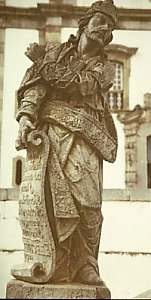Artist’s quest for the meaning of life leads to realization that the power of art — and good will — can bring justice to the world
With all the unrest in the Philippines, people there, like people in my own country Brazil, are yearning to know what will make for true economic and social justice. This knowledge is in the great education of Aesthetic Realism, founded in 1941 by the American poet and critic, Eli Siegel.
 I am enormously thankful for what I learned from Aesthetic Realism about what it means to be just to people, for it dramatically changed my life. As a boy and young man growing up in Brazil, I felt the way to take care of myself was to get ahead, have lots of money, and impress people. But as I acquired these things and more, I also began to dislike myself, and I didn’t know why. I found the answer in the international periodical The Right of Aesthetic Realism to Be Known, where Eli Siegel explains:
I am enormously thankful for what I learned from Aesthetic Realism about what it means to be just to people, for it dramatically changed my life. As a boy and young man growing up in Brazil, I felt the way to take care of myself was to get ahead, have lots of money, and impress people. But as I acquired these things and more, I also began to dislike myself, and I didn’t know why. I found the answer in the international periodical The Right of Aesthetic Realism to Be Known, where Eli Siegel explains:
Aesthetic Realism says that the more we can truly like in this world, the more that is not ourselves we can see as increasing what we are, the more we know ourselves and are taking care of ourselves.
The desire to like the world and to be fair to it, Mr. Siegel showed, is the deepest desire of every person. And I learned that every person has another desire: contempt — “the lessening of what is different from oneself as a means of self-increase as one sees it” — which is the most hurtful, weakening thing for a person’s life.
My inner struggle between wanting fairness and contempt took many forms. I loved reading about how people lived in other countries. When my parents gave me a book on Tyrolean architecture, I felt wonder just looking at those Alpine homes, seeing the great thickness of the exterior walls punctured by small windows, both to protect people from the severe winter cold. This was so different from the tropical homes I knew, built as open as possible to bring in cooling breezes. The massive and severe Alpine facades had colorful, delicate paintings on them. Though I didn’t know it, I was liking the world through those severe but graceful, enclosed but welcoming houses.
Yet, there were other ways I tried to take care of myself. I eagerly looked forward to bringing friends to visit my family’s cocoa plantation. As the car drove down the road, and the enormous white plantation house appeared from behind the sloping grass field, I awaited my friends’ expressions of amazement and got a thrill, thinking contemptuously: “Now they know how superior I am; I belong to superior people who own this plantation, and look how humble I am for not boasting about it!”
Meantime, soon after, we would come upon stark, tiny houses, with children in front dressed in torn clothes — children of the men whose back-breaking work paid for our mansion and the luxuries we greedily kept to ourselves.
Aesthetic Realism is tremendously necessary because it shows that contempt is the cause of all injustice including in economics. Contempt had my family feel we had the right to use people’s lives and hard work, to maintain our comfort and alleged superiority. “Only contempt,” Mr Siegel explained, “could permit a man to make money from the work of another–as man has done these hundreds of years.” Contempt, I learned, is the basis of our brutal economic system, where the work and lives of many people are used to make profit for a few.
Had my family and I wanted to respect these individual human beings, to see their feelings as real, we never would have taken away the wealth they produced. Had I asked: What do they and their children deserve? How does a father feel not being able to buy things for his family? Do those children dream of having a comfortable bed like mine or a musical instrument to play? How does a mother feel dressing her children in torn clothes?–had I asked these questions I would have never been able to justify our exploitation of them.
My contempt made me brutal in ways which now make me cringe with remorse. On Sundays, the workers with their families, dressed in their best clothes, walked for hours on dirt roads to the neighboring town to go to church and buy supplies. The heavy winter rains covered these roads with huge pools of mud. My friends and I amused ourselves by speeding our car over these large pools as parents and children walked by, covering them with mud. We would roll with laughter as we sped away, feeling we could do whatever we wanted to other people. I regret my brutality, my insult to people’s dignity and feelings, and I thank God that I had the great good fortune to meet the education able to change how I saw people.
Aesthetic Realism is merciful in showing that while contempt gives a quick pleasure, it ruins people’s lives. By the time I was in my early 20’s I was desperate: I couldn’t sleep, took Valium daily, and constantly worried at how separate and lonely I felt. I was so fortunate to begin learning in Aesthetic Realism consultations how to see people in a way that makes for self-respect and true kindness.
“Do you think you paid a high price for all this contempt,” I was asked in my first Aesthetic Realism consultation.
“Yes,” I said, “It is a high price; it doesn’t make me happy.”
“Did it make you very lonely,” my consultants asked.
“Yes,” I said, “even when I am surrounded by people.”
They asked me, “Do you see yourself as more like or different from other people?”
“Different,” I answered.
“And when you see yourself as different,” they continued, “do you see yourself as better?” I did.
I was given the assignment to ask whenever I met someone: “Do I want to respect this person or to have contempt? Where am I like this person? And what can I learn from him or her?”
Asking these questions revolutionized how I saw people and my whole life! As I consciously opposed my desire for contempt and wanted to see how I was like other people and be fair to them, my loneliness ended, I no longer day-dreamed of being someone else, and I began to feel at ease under my skin. I saw that I would take care of myself by respecting and seeing meaning in what is not myself! And I came to have a growing passion, that I am grateful to feel: that people in Brazil and everywhere get what they deserve: that they own the wealth they create.
Today, my education continues in the culturally magnificent classes for Aesthetic Realism consultants and associates taught by Ellen Reiss, the Aesthetic Realism Chairman of Education, whom I love for her integrity and good will.
An Artist Represents What the Self Wants Most
I speak now about a person whose turbulent life and beautiful work show vividly what Aesthetic Realism explains–that justice to the world is the only way to take care of ourselves. He is the 18th century sculptor and architect Antonio Francisco Lisboa–the most beloved artist of Brazil, described by Sir Banister Fletcher in A History of Architecture, as an “architect-sculptor of genius.” His treasured stone and wood sculptures are the more remarkable because he created most of them after his fingers were consumed by leprosy. Despite incredible physical pain and exhaustion caused by this brutal disease, he created magnificent sculptures with instruments tied to what was left of his hands. For this, he is warmly called by Brazilians “O Aleijadinho,” The Dear Crippled One.

Among his works are the statue The Flagellation of Christ; St. Francis of Assisi Church, regarded as Brazil’s greatest work of Baroque architecture; and his statues of the Prophets which include Ezekiel, Joel, Nahum.
During the last 37 years of Aleijadinho’s life of 80 years, leprosy, which then had no cure, increasingly consumed his body. The face of Aleijadinho, who had created such beautiful expressions, became horribly disfigured; his swollen eyelids obstructed his vision; his fingers became paralyzed and most of them fell off. Yet, instead of using his agony to give up on art, biographer Fernando George writes that his sculpture, “without doubt became freer and more daring.”
The reason, so important for every person’s life now, is explained by Eli Siegel:
An artist wishes to be fair both to reality as it is and to reality as an individual can see it in his deepest, most graceful effort to have a world he can say he likes;…Art in general says that the painful, the discordant of the world, the seemingly senseless, can be seen with indefinite grace, control, artistic validity.

The world Aleijadinho was born to in 1730, had a terrible relation of wealth and beauty, and enormous human suffering. His father was a prominent Portuguese contractor and architect. His mother, of African origin, was his father’s slave and mistress. Because his mother was a slave, Aleijadinho was born a slave, but was freed by his father at baptism. He was born during the gold rush, during the 70 years when gold was so abundant in Brazil and the country produced what the rest of the world would take three centuries to produce.
The people who produced all this wealth were thousands of African slaves, brutalized by laws that punished slaves who tried to escape by branding them or cutting off their ears. Slavery, said Mr. Siegel: “is the epitome of the feeling, You are different from me, therefore you are less; I do not have to see you as real.”
Though famous, Aleijadinho met that contempt through laws prohibiting people of mixed race from certain professions. Yet, as an artist he was impelled to be just to the world and to see large meaning in it. Aleijadinho also had a great anger, and biographers write of his “irritable temperament” which grew as the disease progressed. Rodrigo Jose Ferreira Bretas described two things in him:
The awareness (he) had of the unpleasant impression that his face caused, made him intolerant and even angry with all who seemed to be purposefully observing him; nonetheless, he was cheerful and jovial among those close to him. His prejudice against everyone was such, that he would become annoyed even when people…gave him praise for his mastery as an artist, judging these to be ironic and expressed with mockery and scorn for him.
To conceal and protect himself, Aleijadinho went to work at dawn, hid behind a tent, and returned home after nightfall. An early document tells that while he was working inside a church: “a villager admiring the perfection of the work created by hands which held the instruments artificially, exclaimed: ‘What hands!’ (Aleijadinho) taking that to be disdain for his handicap answered with fury…’These (hands) that you see were once like yours, which may become like mine!’”
It is heartbreaking that he had to endure this. He struggled between a desire to be kind, and to retaliate against a world he saw as cruel, and people more fortunate than himself. He relied on three men, who were his slaves. Yet while he wrote letters making them free, he locked these away. One man, Mauricio, was a wood carver whose job was to tie Aleijadinho’s instruments to his hands and arms. Aleijadinho would brutally hit Mauricio, yet he shared all his income equally with him.
I am grateful for an Aesthetic Realism class in which I learned from Ellen Reiss about the fight in me between wanting to be kind and feeling I would take care of myself with scorn and anger. On a more personal level, when I was just beginning to care very much for a woman named Zehava Fishman, who is an Aesthetic Realism Associate and now my wife, I found myself acting cool and saying things she had a right to object to. Miss Reiss said with great kindness:
Aesthetic Realism, among other things, is the study of the two selves in people. Contempt…can make for the desire to have another person squirm….On one hand there is a desire in you to love and respect very much, and then to have ill will.
And Miss Reiss asked me: “Do you think because you can act gentlemanly you don’t have to be a critic of yourself? Is there anything that can match the pleasure of meanness?” She explained: “Aesthetic Realism makes it clear — it is art, it is good will.” She asked me to see the power that good will and art make for. What I learned changed me, enabling me to be a better critic of myself. I am glad to say that Zehava and I have been happily married for ten years which I treasure.
Eli Siegel described the power of good will in art, and made it possible for everyone to have it in our lives. He wrote:
The artist…abandons his acquisitive, protective, grudging self to see reality more courageously, generously, fully than usual. Art is an original way of doing justice to things. The artist then wants to see sincerely, as something deserves.

Ezekiel Mr. Siegel explained that what an artist sees and gives form to in a specific object or human expression, is the aesthetic structure of all reality. “All beauty is a making one of opposites,” he stated, “and the making one of opposites is what we are going after in ourselves.” We see, for instance, in Aleijadinho’s most famous work, the statues of the Prophets, opposites central in the world and in his life: motion and rest; tumult and tranquility. Fernando George says the “prophets create an impression they are in states of distress, under the effect of apocalyptic visions.” While they seem to be doing different things — some moving, some at rest, some with arms upwards, another down, some looking up, others down or to the side — yet we also see composition.

Motion and rest are beautifully, surprisingly one, in the statue of Ezekiel, which I love. He seems to be moving with such energy, his arm curved across his body, his hand near his shoulder. Yet, there is also rest as his left hand holds open a scroll and his right foot is firmly planted on earth. A heavy fabric band along his waist visually anchors Ezekiel, accenting motion because of its diagonal. It repeats the curved form and motion of the arm and closed hand moving upward, but its direction is downward. I was surprised to learn that the statue once held a sword in its closed right hand, which, according to the Bible, Ezekiel was ordered by God to use to punish the people of Israel.
My colleague, Aesthetic Realism consultant and painter, Dorothy Koppelman, pointed out that rest and motion are also made one through “counterpoint,” a technique in sculpture. That is, while his upper body moves backward, is recessive, the lower half moves forward, with his right leg going forth. There is tension caused by these opposing directions.
Ezekiel is terrified when he sees the car and wheel of God in the sky. Yet, Mrs. Koppelman pointed out, the statue also looks thoughtful because there is resolution of these back and forth motions: they are one. In the Bible, God asks Ezekiel not to be afraid but to go forth to Israel, speak to people, have them change; and if they did not, to punish them with the sword.
Rest and motion, receding and going forth, terror and thoughtfulness, were crucial in Aleijadinho’s life, as they are in people everywhere. I am grateful for his courage, and I love Eli Siegel and Aesthetic Realism for giving people at last, what Aleijadinho was unconsciously going after in art and life: the way of seeing people which makes for justice and by which we can really like who we are.
Sergio Silveira, a native of Salvador, Brazil, is an architect in charge of construction of public libraries in New York, where he currently lives. He is also an Aesthetic Realism Associate studying to teach Aesthetic Realism in classes taught by Chairman of Education Ellen Reiss. For more information, contact the not-for-profit Aesthetic Realism Foundation, 141 Greene Street, New York, NY 10012; (212) 777-4490; www.AestheticRealism.org

